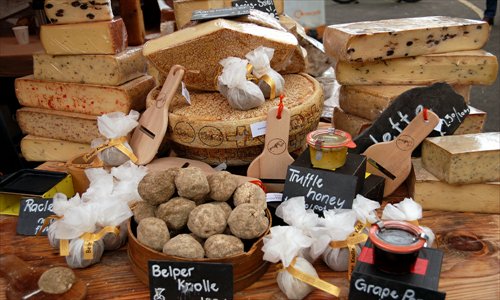Promenade in London



"Sir, when a man is tired of London, he is tired of life; for there is in London all that life can afford." This is how in the 18th century Dr. Samuel Johnson defined the British capital, and this is how many people would still define it today. Packed with iconic landmarks, London never fails to attract millions of tourists every year. Even without boasting a city center crammed with thousand-year-old vestiges, it has managed to earn a status as a tourist draw. Don't be surprised to see a mob of tourists queuing in front of an old-fashioned red phone booth waiting their turn for a photo op, or worse, when you find yourself queuing up with them.
With its thriving market scene and emblematic milestones, one doesn't just visit London, one experiences it. If you think traveling means integrating with locals, London might well be what you are looking for. Its purely tourist-aimed attractions can be visited in the span of a couple days, and the rest of the stay is all about becoming and living like a proper Londoner.
Feeling at home
During my recent trip, having already taken my dose of popular tourist draws when I lived there, I decided it was time to go off the beaten path and challenge myself on how local I could become in one of Europe's most eclectic capitals, where, as my friend Alex once told me, "Everyone is allowed to embody their own character." It's only recently, about three years after I left Britain, that I've been realizing that I had only dug so far into the multicultural aspects of the city, without really getting to know its more intimate British soul, which, ironically, defines the unconventional track here. This is how I tailored myself an itinerary in the quest for what's left of Victorian and Elizabethan London, defying the crowds, but not managing to avoid them entirely.
My first stop in this experiment saw me whirl back to the 17th century to explore how social changes and mores have shaped British homes and tastes over the past 400 years. Journeying through the old parlours and drawing rooms, short for "withdrawing rooms," at the very English Geffrye Museum offered a precious glimpse onto four centuries of private life. A former almshouse in cosmopolitan East London, the museum allowed me to quietly spy on the household practices of the affluent "middling sort" and picture its members in their daily activities, either working at home, entertaining their guests or enjoying themselves by playing, painting or reading.
An originally sturdy tradition of furnishings soon evolved into a "neat" and bright pattern, in line with more relaxed living manners. The parlour, where owners used to receive their guests, required a certain degree of "politeness," so it's not incorrect to place the birth of the country's trademark social habit, much encouraged to this day - "Are you alright, love?" is bound to become the refrain of your stay - right here in these rooms. Good manners required Londoners to make pleasant conversation, avoiding extremes of opinion and temper, stand correctly and graciously take tea, the "medicinal herb" from China. From oak paneling to brick chimneys, from elaborate curtains and ornamental balconies up to loft-style 20th-century decorations, I made my way through years of the architectural styles of the British middle class. Ironically, the museum lies in a district that became home to immigrants and outsiders over the years, and where now lie some of the most vibrant markets in town.
To market, to market
As the Geffrye Museum opens at noon on Sundays, my visit ended right on time for a sensory stroll through Brick Lane and Spitalfields, the best places to immerse myself in the kind of vibrant atmosphere I have learned to expect from flea markets selling merchandise, food and produce from all over the world. Setting out from the diverse assortment of the Old Spitalfields, one of the finest Victorian markets in London, to graffiti-clothed Brick Lane, I shopped my way through vintage stalls, glamorous jewelry and handmade clothes and accessories, until it came time for lunch. I tickled (and pleased) my senses with the huge selection of mouthwatering specialties ranging from northern African couscous to Indian curry, from spicy Mexican to heavenly, daring Ethiopian vegetarian.
Loud and colorful, Brick Lane, a centerpiece of immigrant communities and working-class members for centuries, is now one of the most multicultural and exuberant hubs in London. Home to producers and traders of bricks and tiles since the late 16th century, the area has always been poor and inhabited mainly by silk weavers and Huguenots, religious refugees from the Netherlands and Belgium. In recent years, the Spitalfields neighborhood has been evolving and adapting to its ever-changing residents, from its creation as a Roman burial ground, to its life as a Jewish quarter, up to the Bangladeshi community that today gives the area its unmistakable subcontinental colors and tangy curry smell.
Anyone who thinks of the quintessential British experience as the ultimate mission of their London trip or, like me, wants to find an excuse for unfamiliar photo excursions, cannot overlook Portobello Road Market, tucked away in formerly middle-class Notting Hill, home to one of the world's biggest carnivals. Portobello Road boasts a healthy collection of antiques, improbable fashion design, vintage prints and the inevitable street food section, creating the kind of vibe that would make Samuel Johnson proud all over again.
While fruit and vegetable stalls are set up daily, antiques and outlandish bric-a-brac only appear on Saturdays, when nostalgic Londoners and curious tourists blend in a district redolent of the Industrial Revolution. The area has clearly been gentrified into a residential Victorian neighborhood dotted with typical terraced townhouses and private gardens, yet retains much of its original identity.
Delving into the past
If you haven't overdosed on street food yet, take a tantalizing trip around Borough Market on a weekday lunch hour to treat yourself to arguably some of the tastiest (and priciest) gourmet delicacies in town. After eating your fill, skip on over to the London Bridge and then immerse yourself in a Shakespearean atmosphere at Shakespeare's Globe. Fans of the playwright can enjoy masterpieces such as Macbeth and A Midsummer Night's Dream just a few hundred meters away from the former site of the playhouse he wrote for. Situated on Bankside along the Thames, the "new" Globe Theatre construction was built to recreate, as closely as could be known, how the original theater looked. Destroyed by a fire in 1613, then rebuilt only to be closed along with all theaters in 1642 under Puritan rule and finally demolished in 1644 to build tenements instead, Shakespeare's Globe was built according to only old prints and personal accounts in an attempt to reproduce the settings from which Shakespeare himself had drawn inspiration.
A visit to London cannot be considered complete without a tribute to at least one of its churches, and mighty Westminster Abbey aside, where kings and queens have been crowned since 1066, a must-see is the Temple Church. This magnificent and fascinating place of worship was built in the 12th century by the Knights Templar, Crusaders in charge of protecting pilgrims going to and from the Holy Land. Designed to be reminiscent of Jerusalem's Church of the Holy Sepulchre, the most important site for the Crusaders, today the Temple Church is a favorite among Da Vinci Code fans, as a scene from the movie was set here.
Mixing old, legendary, vintage and modern, over the years London has managed to give itself a reputation as a trendy melting pot, where anything can be found and any need can be met. Diversity is what best defines the English capital, and maybe this is what makes me and all the other expats in the city never feel like a foreigner there.
Rules of Thumb
Practical information: The local currency in London is the pound sterling, and although life here is very expensive, it's possible to organize a holiday without spending too much on accommodations and meals by finding affordable prices and deals. Many attractions and museums in London are free of charge, with the exception of places such as Madame Tussauds, Westminster Abbey and the London Transport Museum.
What to wear: Very cold in winter and mild in summer, London's weather is unpredictable all year round, with frequent showers in all seasons and sudden drops in temperature.
Where to stay: London offers a huge range of accommodations, from 5-star hotels to B&Bs and hostels from 12 pounds ($18) per night.
Transportation: Most metro stations close around 11 pm or midnight on weekdays, while on the weekends some metro lines remain closed. However, the city is well served by night buses. London has four main airports, Heathrow, Stansted, Gatwick and Luton, although all intercontinental flights land at Heathrow, whose terminals are served by the Piccadilly Line which connects to the city center and other metro lines. The other airports, mainly connecting London to other European cities, can be reached from the city by trains and buses that run regularly from the stations of London Victoria and Liverpool Street.